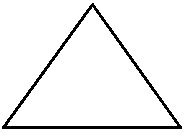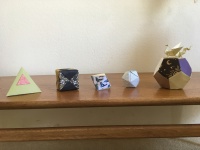In his fascinating book
The Twilight of Pluto, John Michael Greer develops the thesis that the discovery and demotion of a planetary body “reflects significant changes in the constellations of astrological forces that define the inner landscape of human life.... As we move closer to the final stages of Pluto’s twilight, the rebirth of cosmos will be fact of the first importance, culturally, psychologically – and spiritually.”
Being recast as a Dwarf Planet may signify that Pluto’s meaning and influence are being clarified, condensed and reshaped in human consciousness. My intent in this meditation is to characterize some of those changes as I see them. I develop the idea of a dynamic triad connecting Pluto, the dwarf gods known as Cabiri, and the Hermit of the Tarot. I then propose a new name for the dwarf planet formerly known as Pluto: Pluto Telesphoros.
9th Planet<--> Pluto <-->Dwarf Planet

9th Tarot: Hermit Cloak, lantern <-------------------> Cabiri; cloak, lantern-->Telesphoros Figure 1 Squatting Kabeiros,Ibiza. Circa 210-early 2nd Century BC.Dwarf Archetype: The Cabiri
Figure 1 Squatting Kabeiros,Ibiza. Circa 210-early 2nd Century BC.Dwarf Archetype: The Cabiri Greek myth identifies the Cabiri (Greek Kabiroi) as divine craftsmen. As far back as the 5th century BC, the Cabiri were celebrated at the mysteries of Lemnos and Samothrace. Some scholars held them to be the "great gods," the primal deities of Greek mythology, from which all others developed.
The history of Cabiri cults reveals an interesting dynamic in which the Cabiri were associated with various chthonic deities, including Dionysus, Hermes, Demeter, Ceres, Persephone, Hades, Hephaestus (Vulcan), Hecate, and, as in our own time, Pluto.
“The chief seats of Cabiri worship were Lemnos, Samothrace, Thessalia, and Boeotia. They were originally only two in number, the elder identified with Dionysus, and the younger with Hermes…. Their worship was later amalgamated with that of Demeter and Ceres, with the result that two sets of Cabiri came into being—Dionysus and Demeter, and Hermes and Ceres. A Greek writer of the second century B.C.E. states that they were four in number—Axisros, Axiokersa, Axiokersos, and Casmilus, corresponding, he states, to Demeter, Persephone, Hades, and Hermes.
“The Cabiri were often mentioned as powerful magicians, and Herodotus and other writers speak of the Cabiri as sons of Vulcan. … Strabo, on the other hand, regarded them as the ministers of Hecate, and Bochart recognized in them the three principal infernal deities, Pluto, Proserpine, and Mercury.”
1
Jung’s Telesphoros
 Figure 2 Jung's Telesphoros
Figure 2 Jung's Telesphoros
At the center of the stone he created for his garden at Bollingen, Carl Jung carved a small dwarf figure that he described as
“…a kind of Kabir, or Telesphoros of Asklepios.
2 Ancient statues show him wearing a hooded cloak and carrying a lantern. At the same time he is a pointer of the way. I dedicated a few words to him which came into my mind while I was working. The inscription is in Greek; the translation goes:
“Time is a child – playing like a child – playing a board game – the kingdom of the child. This is Telesphoros, who roams through the dark regions of this cosmos and glows like a star out of the depths. He points the way to the gates of the sun and to the land of dreams." (Jung,
Memories Dreams and Reflections, p. 225ff.)
This describes a position remarkably like that of our dwarf planet Pluto, who circumnavigates the dark outer shores of our solar system, pointing toward our Sun through the gates of Neptune, our outermost planet and ruler of dreams in astrology.
Additionally, Jung commented on the Cabiri scene in Goethe’s
Faust (Part II, Act 2):
Nereids and Tritons:
Great Cabiri do we bear,
That our feast be friendly fair.
Where their sacred powers preside,
Neptune’s rage is pacified.“The Nereids and Tritons are feminine figures who represent the sea and the waves of the unconscious. They bear the Cabiri, unseen, creative dwarf-gods, hooded and cloaked manikins…who appear on the seashore…where, as kinsmen of the unconscious, they protect navigation, i.e. the venture into darkness and uncertainty.” (Jung,
Psychology and Alchemy, CW 12, §§ 203ff.)
Jung also wrote:
“The Cabiri are, in fact, the mysterious creative powers, the gnomes who work under the earth, i.e., below the threshold of consciousness, in order to supply us with lucky ideas.… They give an eye to everything that has not already been anticipated by consciousness and the functions at its disposal…. Deeper insight will show that the primitive and archaic qualities…conceal all sorts of significant relationships and symbolic meanings, and instead of laughing off the Cabiri as ridiculous Tom Thumbs, we may begin to suspect that they are a treasure-house of hidden wisdom.” (Jung, “Attempt at a Psychological Interpretation of the Dogma of the Trinity,” CW II,§ 244).
The Hermit
 Figure 3 L'Ermite, Augustus Knapp
Figure 3 L'Ermite, Augustus KnappPluto, when it was still considered a planet, was the 9th planet in our solar system. This suggests a possible symbolic relationship with the 9th card of the Tarot, the Hermit.
According to Eliphas Lévi, one of the symbolic meanings of The Hermit is Initiation. (Lévi,
The Doctrine and Ritual of High Magic,Chapter 9.) According to Greer, the demotion of Pluto may correspond to the Initiation of the Nadir, the idea that the descent of Spirit into Matter in the individual and collective human soul reaches a turning point where it begins its return journey back to Spirit. This corresponds to the “dark night of the soul” described in occult and mystical literature as the experience of losing contact with the spiritual realms. (Greer, p. 144)
In Jung’s
Liber Novus, there is a dramatic scene in which the Cabiri speak to Jung and say:
“He who wishes to conquer new land brings down the bridges behind him. Let us not exist anymore. We are the thousand canals in which everything also flows back again into its origin….” (Jung,
Liber Novus, p. 321)
This suggests an intriguing a parallel between the Cabiri, the Hermit, and the Initiation of the Nadir. The Hermit, like Jung’s Telesphoros, cloaked and carrying a lantern, embarks on a solitary journey with his lantern (knowledge), his cloak (solitude) and his staff (magic) to protect and guide him through the dark night of the soul.
ConclusionIn light of the above musings, I propose a new name for the planet formerly known as Pluto:
Pluto TelesphorosThe Plutonian Era brought about the boundary-dissolving eruption of the collective unconscious into human awareness, as explored and eloquently mapped in Jungian psychology. Pluto Telesphoros heralds an evolutionary night sea journey, a deepening and expanding of the landscape of human consciousness. Pluto Telesphoros can be seen to represent the magical, chthonic forces of the Cabiri, who bring up from the depths the necessary material to create the transcendent vehicle that will carry human consciousness forward on its evolutionary journey: the Soul’s ascent from Matter to Spirit.
1 https://www.encyclopedia.com/philosophy-and-religion/ancient-religions/ancient-religion/cabiri2 In ancient Greek religion, Telesphoros was a minor child-god of healing. He was a possible son of Asclepius and frequently accompanied his sister Hygieia. He was depicted as a dwarf whose head was always covered with a cowl hood or cap. Telesphorus is assumed to have been a Celtic god in origin, who was taken to Anatolia by the Galatians in the 3rd century BC, where he would have become associated with the Greek god of medicine, Asclepius.
https://en.wikipedia.org/wiki/Telesphorus_(mythology)





